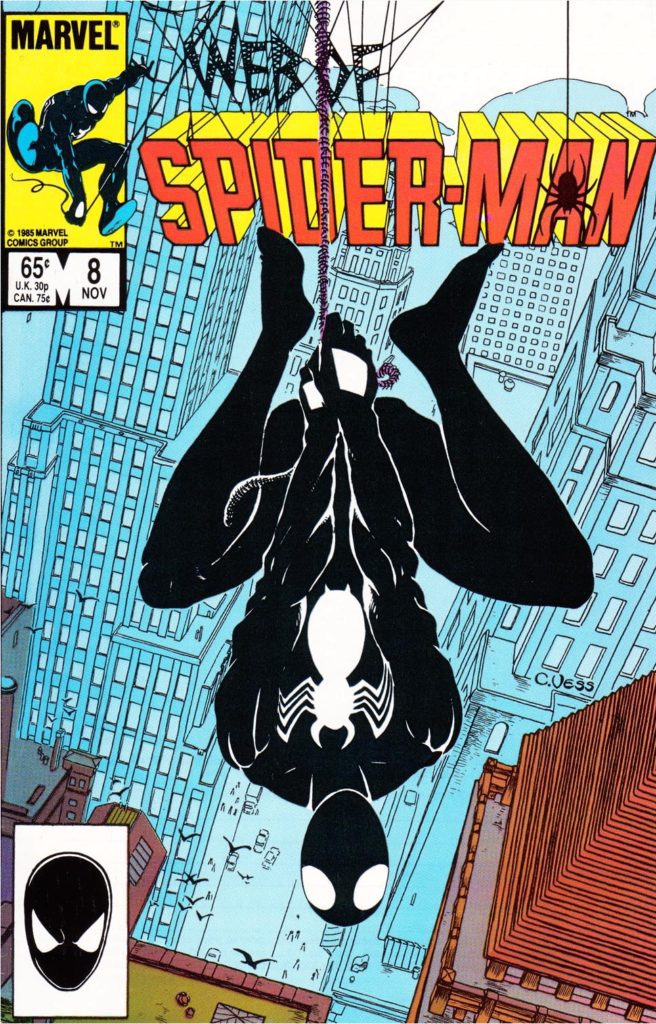
Spoiler Alert: If you have not read Web of Spider-Man #8 and #9 from November and December 1985 respectively, there are significant spoilers in the article below. You have been thusly warned.
Everyone has heard of Spider-Man. Most people have read a Spider-Man story or two, or at least seen a movie or cartoon featuring New York’s favorite web-slinger. However, what you may not realize is that amongst the thousands of Spider-Man stories in print and video are quite a few rather powerful stories. These are stories that don’t just tug on the heartstrings, but also provide a social commentary on our world. Parables, human interest stories, small dilemmas that every one of us faces, all are faced by Peter Parker, the Amazing Spider-Man. Spider-Man has always been a comic book that showed us our humanity as reflected in the visage of a man who’s very abnormal story puts his mundane life into stark relief in a way that virtually everyone can identify with. Relationship issues, paying the bills, facing moral dilemmas–these are all things that happen to each and every one of us every day.
One such story was written back in 1985 by David Michelinie and featured in Web of Spider-Man # 8 and #9, a two part story featuring a gorgeous cover by Charles Vess on issue 8 (as shown above). Within the pages of this story lie not only some painful truths about our humanity, but in several ways, a reflection of our society today written over thirty years ago. The story is entitled ‘Local Super Hero!’ and starts off in 1954, with a gay bank teller named Fred Hopkins and his male co-worker Irving getting tickets for the orchestra in the small town of Smithville, Pennsylvania. Outside the theater, the co-worker is attacked for being Jewish and thrown into the back of a pickup truck by local ruffians. Fred attempts to pursue but is thrown from the pickup truck and rolls roughly into a junkyard where he encounters a meteor which *cough* gives him super-powers.
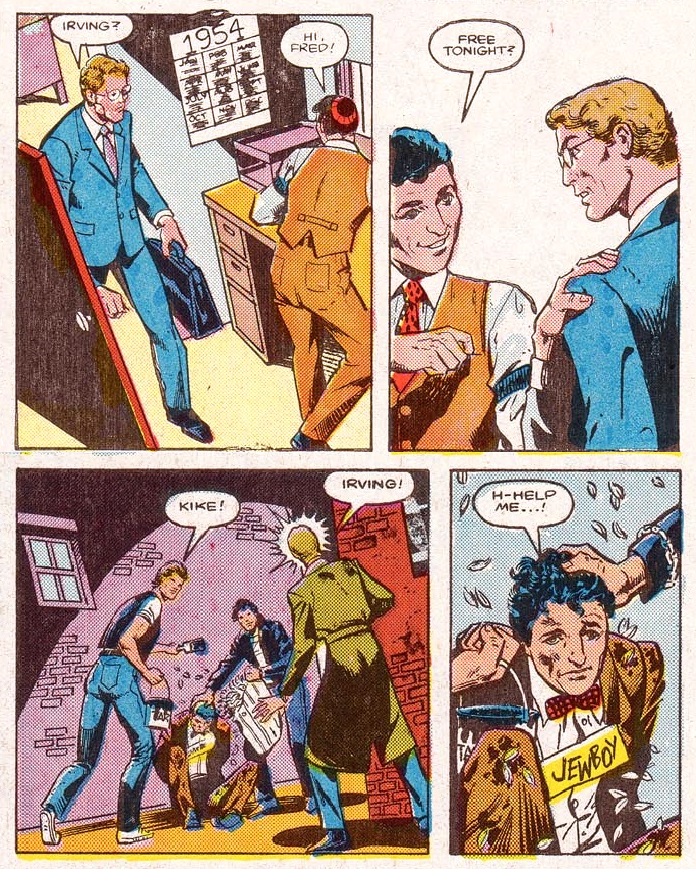 Now, keep in mind this is 1985 and we’ve already seen obviously gay men and anti-Semitism by page 4! Homosexuality was barely addressed then, and certainly rarely in comics. In addition, highlighting the violence against the Jewish community is definitely not something one would expect to read in a random Spider-Man issue. But there’s more. A couple pages later, Fred witnesses two local white boys beating an African-American boy and calling him a “clumsy coon!” And the boy apologizes to his tormentors! Sure this is supposed to be in 1954, but it’s in a comic book in 1985! That’s certainly something that is unlikely to be found in any comic on the racks today. But why is that? Why are we so afraid to revisit the actual events that used to happen on a daily basis throughout America? And why was it acceptable to do so in a superhero comic book from 1985 but it isn’t today?
Now, keep in mind this is 1985 and we’ve already seen obviously gay men and anti-Semitism by page 4! Homosexuality was barely addressed then, and certainly rarely in comics. In addition, highlighting the violence against the Jewish community is definitely not something one would expect to read in a random Spider-Man issue. But there’s more. A couple pages later, Fred witnesses two local white boys beating an African-American boy and calling him a “clumsy coon!” And the boy apologizes to his tormentors! Sure this is supposed to be in 1954, but it’s in a comic book in 1985! That’s certainly something that is unlikely to be found in any comic on the racks today. But why is that? Why are we so afraid to revisit the actual events that used to happen on a daily basis throughout America? And why was it acceptable to do so in a superhero comic book from 1985 but it isn’t today?
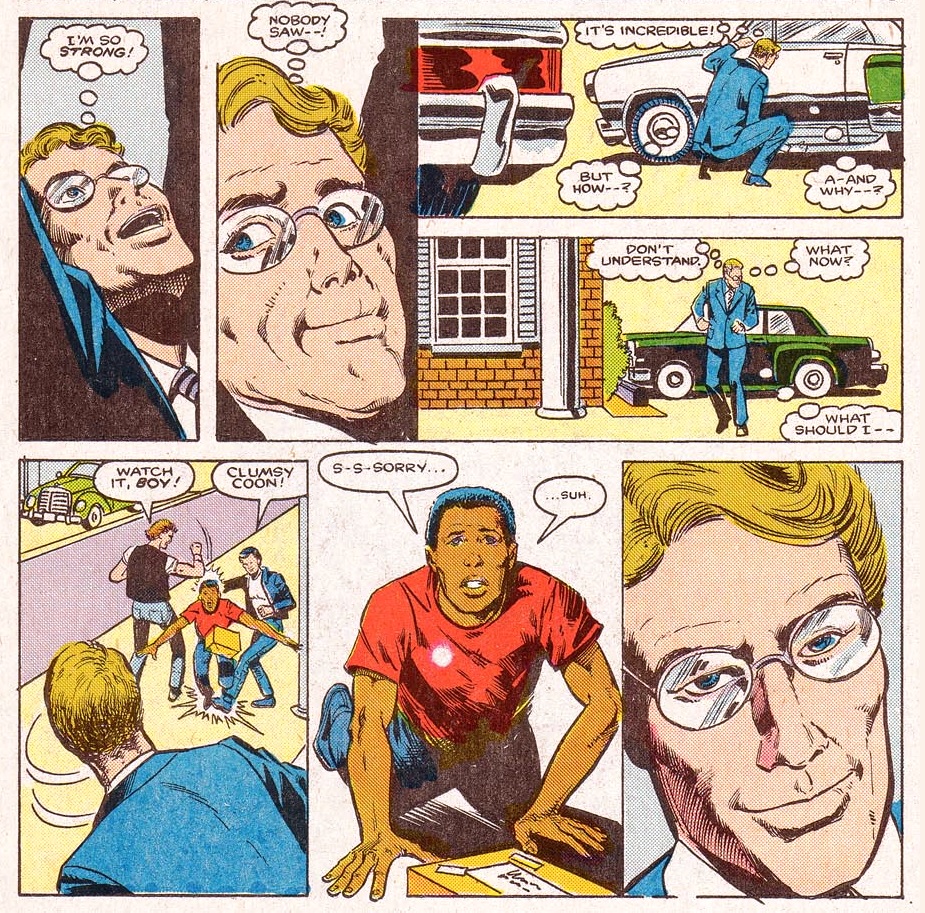
Fred realizes that he has super-powers and becomes a ludicrous hero named “The Smithville Thunderbolt” and beats up the local baddies that were picking on neighborhood denizens. Then we skip forward 30 years to Peter Parker being given an assignment to go to rural Pennsylvania to investigate the Smithville Thunderbolt. Pete takes the Greyhound from NYC all the way to Pennsylvania and immediately stumbles on a fire which the Thunderbolt is rescuing people and also encounters a very large, very strong angry redneck in overalls. After this encounter, Peter barely gets a chance to breathe before meeting the local newspaper reporter, Roxanne DeWinter. She’s on the prowl for a big story to catapult herself out of Smithville and into the big city and she sees Pete as the worm that will bait the hook. Peter manages to hunt down Fred Hopkins fairly quickly, jumps into costume as Spidey, and confronts him. Fred is embarrassed and comes clean with such immediacy that it’s obvious he’s wracked by guilt. It turns out he’s been manufacturing fake accidents for the Smithville Thunderbolt to rescue people from because his powers have faded but he was so consumed by adoration from the townsfolk that he couldn’t bear to retire. This is certainly a pretty terrible way to stay in the spotlight, and Fred knows it. It also feels like another thread that’s more modern than one might expect in our storyline. We’ve had racism, anti-Semitism, and homosexuality, and now we’re adding a healthy dose of narcissistic behavior to the mix. Interestingly enough, the same type of narcissism that infects social media today. Just look at selfie-obsessed millennials or Twitter posts. Both are manufactured to a large degree for notoriety or commercial gain or both. People literally manufacture images and personas just to market themselves and stay popular, just like poor old Fred Hopkins.
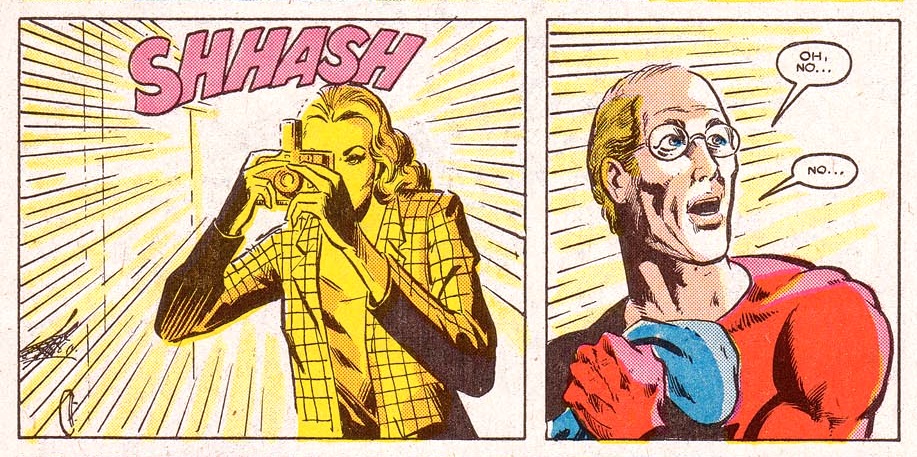
Of course, our plucky reporter Roxanne pops in just as Fred is holding his Smithville Thunderbolt mask in his hands and snaps some damning pictures, Spidey tries to take her camera, and the giant redneck busts through the wall ending the first half of our duology. We are left with your standard cliffhanger but definitely not your standard story. Thematically, Michelinie has already dissected the standard myth of the small town where nothing happens, put it firmly into rural Pennsylvania, where people traditionally don’t think of these sorts of events happening, and added a couple of interesting moral dilemmas for our main characters. It’s a powerful piece of writing and one that’s coherent and self-contained, something that’s often missing from today’s comics. But let’s look at the rest of the story. There are a few more key elements to go in issue 9.

In issue 9, we discover that the big redneck in the overalls was exposed to another fragment of the same meteor, but much more recently. His sudden super-powers ostracized him from society, his own family and friends rejecting him, the local minister going so far as to call him an agent of the devil. There are some very Frankenstein-esque scenes of his past with townsfolk and torches, somewhat reminiscent of the 1950s in the US, an interesting parallel to the first part of the story which actually took place in the 50s. While he attacks Fred and Spidey, Roxy the reporter snaps a bunch of photos and then zips away from the scene to get them published. Spidey, now dressed as Peter again tries to dissuade her, but she ignores him and leaves immediately for a neighboring town. Cut to Fred again and he’s contemplating murdering Roxy to protect his secret shame, a very human move, but also a shocking one for a comic like this. He ultimately decides against it and leaves his handgun home.
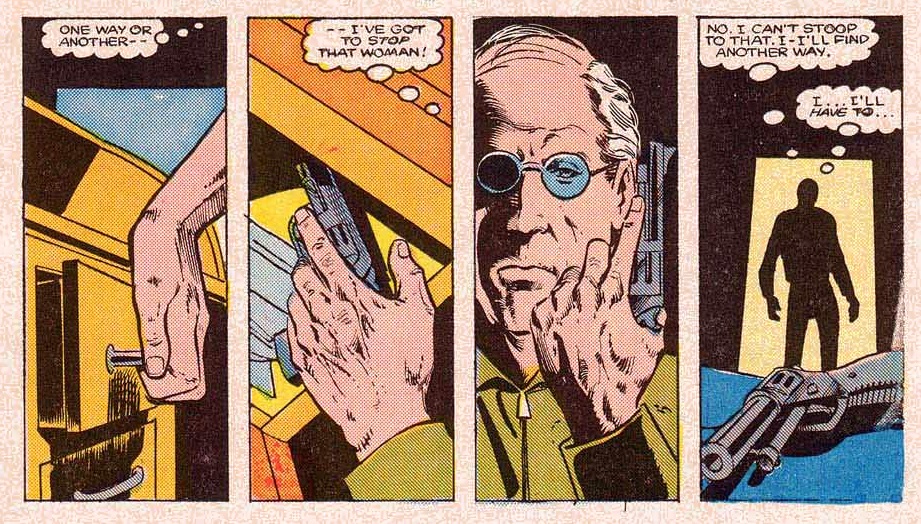
I won’t bore you with the details, but there’s a showdown on a mountain road, The Thunderbolt saves Roxy, the redneck who wanted to kill him realizes they’re more alike than he thought and backs down, and Roxanne DeWinter gets her photos to the publisher. But here’s the important part. A mob of people holding signs approach Fred’s house in the final scene of our story, very much like the villagers that ran our redneck friend out of town. But instead of hating Fred, they’re lauding him for his deeds as the Smithville Thunderbolt. Roxy and Pete argue about her publication of the pictures outside as the mob approaches Fred’s house. Suddenly, there is a gunshot. Pete and Roxy run headlong into the house and find that Fred has taken his handgun and committed suicide out of his shame and fear of being exposed. Pete turns away, disgusted, and the final panel, the one that leaves you shuddering, is of Roxanne DeWinter taking out her camera and coldly photographing Fred’s lifeless body for the evening edition.
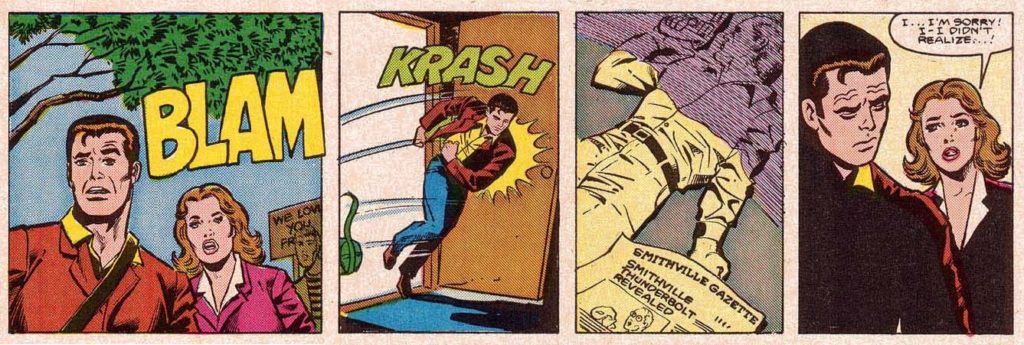
And that’s when it all comes together. This isn’t just a story about a has-been super-hero. It’s a serious commentary on shock journalism and its consequences. One we obviously haven’t learned, judging from the current state of our 24 hour news cycle these days. Today’s news cycle shows brutal violence on screen with reckless abandon. We can stream beheadings on Youtube. We can watch clip shows of live suicides. As a society, we have begun down a slippery slope wherein we no longer care about the human cost of our news and we covet actual violence as entertainment. It’s a problem encapsulated in a single panel at the end of a Spider-Man comic from 1985. We don’t care anymore. We don’t care about Fred, or all the others like him. All the people that have killed themselves as they were exposed for things like being gay or sharing their naked pictures online with unsavory individuals don’t matter to us. It’s just a news story to discuss over the water cooler now. We don’t do anything. We tweet, and we like posts that say how terrible things are, and we hold signs or candles up at gatherings, and we share it on Instagram and Snapchat while we’re doing it.
But it’s what we don’t do that should scare everyone. We don’t comfort those in pain anymore. Most people don’t sit down and try to talk with coworkers who are having a bad day. They don’t take the time to get to know each other anymore, and they certainly don’t take an interest in their problems. We, as a modern society are failing each other. It’s too much work to take time out of our day for someone else. We’ve all got our own problems, right? We don’t have time to spend helping someone else deal with theirs. It doesn’t benefit us. And that’s how we are starting to think as a group. It’s the same reason you see phones come out in an emergency instead of people jumping in to help. Get that video. Sell it to someone. Go viral. It’s actually becoming a rarity to help people personally, and that’s sad. It’s a lesson we should have learned from David Michelinie in 1985 in a comic book, but we never did. We’re all edging closer day by day to becoming Roxanne DeWinter, and we need to take a step back and pay attention to a cautionary super-hero tale from the past.
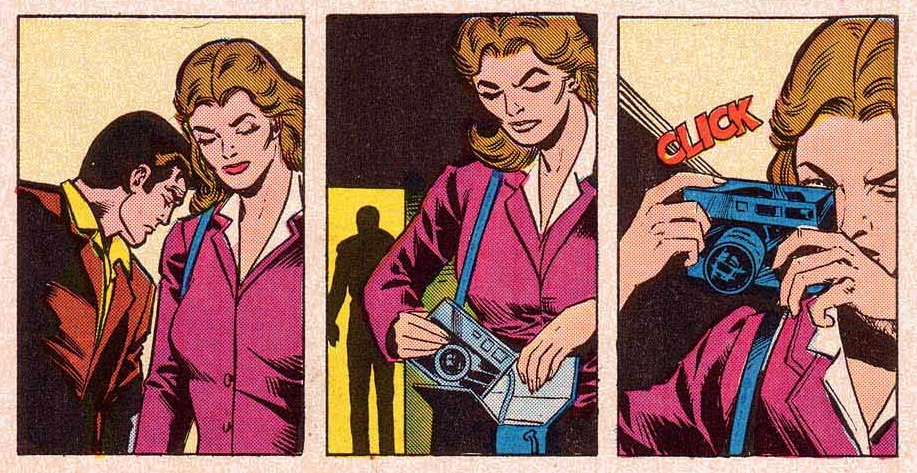
Legal disclaimer: All images and characters in this article are copyright of Marvel Comics.

